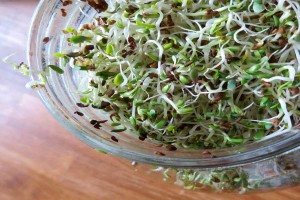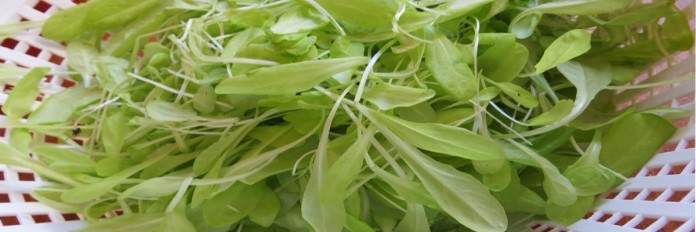Microgreens and sprouts are nutrient dense superfoods that are easy to grow indoors during cool weather.
Microgreens are immature vegetable plants. Vibrant lettuces, spinach and beet greens are a few of my favorites. Sprouts are germinated vegetable and grain seeds. I like broccoli and radish seeds best for their zesty flavor, but clover and alfalfa sprouts offer higher levels of protein and vitamins A, B, C and E than other sprouts.
The difference between microgreens and sprouts is soil, sunlight and time. Sprouting seeds germinate without soil and sunlight. Sprouts are ready to harvest in 5-7 days. Microgreens require soil and sunlight to grow. I fill nursery trays with organic potting mix and position the trays under grow lights. Microgreens are ready to harvest in 14-20 days.
Nutrition
Both microgreens and sprouts are considered superfoods because they pack tons of nutrients, vitamins, minerals and antioxidants in a tiny punch. With zero cholesterol and low calories, eating microgreens and sprouts regularly may reduce the risk of disease. There is evidence that eating superfoods boosts immunity, which makes them perfect to grow indoors during flu season!
The human body absorbs vitamins and minerals better from food than supplements. I quit taking expensive vitamin supplements when I started sprouting and growing microgreens. The nutrition in both superfoods exceeds what my multi had to offer.
Food security
As consumers fill their shopping carts with processed canned foods, bottled water and batteries before an impeding storm, I depend on my stockpile of microgreens and sprouting seeds (in addition to dry beans, root vegetables, poultry and dairy animals) to provide me with essential nutrition during a food emergency. Seeds store for 5 years in airtight containers, twice as long when frozen.

Easy to grow
Sunlight, warmth and good air circulation are critical to growing traditional vegetables indoors during cool weather. Lack in just one of these areas and your indoor garden is likely to fail. Poor luck deters many would-be indoor gardeners from setting up shop. Rest assured that non-traditional microgreens and sprouts are easier to grow indoors and produce a crop much quicker, in as little as 5 days!
How to grow microgreens
Step 1: Purchase seeds. I snatch up vegetable seed packets at end-of-season sales.
Step 2: Prepare a nursery tray with drainage holes. Fill with 2” inches of potting mix.
Step 3: Scatter seeds over soil. Gently press seeds in place.
Step 4: Sprinkle additional potting mix over top of seeds. Lightly water after planting; make sure a drainage tray is in place. Water whenever soil feels dry for the next 14-20 days.
Step 5: Place tray in a sunny window or under grow lights.
Step 6: Harvest after 14-20 days.
How to grow sprouts
Step 1: Purchase sprouting seeds and sprouting jar with screen lid. I buy mine in bulk online.
Step 2: Add 3 tablespoons of seeds to jar. Cover with a few inches of water. Soak overnight.
Step 3: Drain and rinse seeds the next day, and then twice every day for 5-7 days.
Step 4: Harvest after 5-7 days. Refrigerate sprouts in a breathable produce or mesh bag to keep them fresh and crispy.













